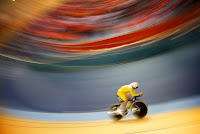 |
| Even though, the study at hand confirms that NaHCO3 doesn't work for everyone previous studies show it's worth trying. |
You will probably have asked yourselves, whether I had already forgotten about
sodium bicarbonate and the performance enhancing effects of pH buffers, right? No, I didn't, but unfortunately, many researchers have... well, many, but not all researchers. Gabriela Froio de Araujo Dias and her colleagues from the
University of Sao Paulo, for example, have just released a paper in which they describe the intriguing results of the first bicarbonate study that was specifically designed to (a) determine within- and (b) inter-individual variation that could potentially compromise the magnitude of an effect that's determined based on averages (e.g. if you use bicarb three times and have performance increases of 0.4%, 5% and 0.3% it will look less effective).
You can learn more about bicarbonate and pH-buffers at the SuppVersity

The Hazards of Acidosis

Build Bigger Legs W/ Bicarbonate

HIIT it Hard W/ NaCHO3

Creatine + BA = Perfect Match

Bicarb Buffers Creatine

Beta Alanine Fails to HIIT Back
In the corresponding experiment, the scientists had 15 physically active males (age 25±4 y; body mass 76.0±7.3 kg; height 1.77±0.05 m) complete six cycling capacity tests at 110% of maximum power output (CCT110%) following ingestion of either
- 0.3 g/kg body mass of sodium bicarbonate (SB | 4 trials) or
- alcium carbonate placebo (PL, 2 trials).
Just in case you're wondering: Calcium carbonate has no reasonable buffering effect as it will not, as you can see in
Figure 1 affect the pH, bicarbonate levels of base excess of the blood in the way bicarbonate does. It is thus the standard choice in corresponding experiments.
 |
| Figure 1: Line graphs for blood measurements (mean ± 1SD) at Baseline, Pre-exercise, Post-exercise and 5-min post-exercise. Panel A displays pH;
Panel B displays bicarbonate; Panel C displays base excess; Panel D displays lactate. PL trials are represented by dashed lines and SB trials are
represented by solid lines (de Araujo Dias. 2015). |
As you may already know from
previous SuppVersity articles on bicarbonate, the increases in blood pH, bicarbonate, base excess and lactate you see in
Figure 1 are important to tell what exactly triggers the net effect of using baking soda as a pH buffer. What every athletes will yet be more interested in, though is whether the buffer allowed the recreationally active men who participated in the study saw statistically significant increases in the total work done (TWD) during the 110% high-intensity cycling capacity test, or not.
You have problem "stomaching" NaHCO3? If you feelm, like some of the subjects in the study nauseated or even get diarrhea when you ingest a large bolus of sodium bicarbonate at once, try the
Serial Loading Protocol from Dreher's 2012 study I discussed in an older
SuppVersity article about sodium bicarbonate. That should work even for the most sensitive tummies. That's still no guarantee that it'll work, though, and would - just as the study at hand shows it for the regular bolus administration require some experimentation.
As you can see in
Figure 2, the average subject saw the highest improvement in the last of the four trials (7%); an improvement of which statistics tell us that it says that there's 93% chance of general substantial improvement - with lower values for the other trials.
 |
| Figure 2: Rel increase (%) in total work (figures over the bars indicate likelihood of relevant benefits and relative increase, e.g. for bar 4: "It's 93% likely that the 7% increase displays a real-world relevant performance increase) - left; Total work done during SB trial as function of total work done during PLA trial - right (de Araujo Dias. 201). |
Apropos "other trials", when the scientists removed the subjects who reported sick during trial 1 and trial 3, the results of trial 1 suggest a "likely" benefit (81%) and those of trial 3 a "possible" (50%) benefit. The notion that whether you benefit or not can / will depend on how well you tolerate the bicarbonate solution would also be confirmed by the data in
Figure 2, right. The latter is a plot of the ratio of total work done in the sodium bicarbonate trial #4 vs. the control trial; a plot that easily tells us who saw benefits and who didn't because all "winners" are above, while all "losers" are below the transverse line. And since the distance to said line is a marker of the performance increase, you can also see that even among those who
did benefit, the benefits ranged from
hardly measurable as in subject #7 to
a whopping 30% increase in total work done during the high-intensity cycling capacity test in subjects #12.
 |
| 25g of Baking Soda Will Up Your Squat (+27%) & Bench Press (+6%) Within 60 Min | more |
Bottom line: If you belong to the unlucky 33%, who were represented in the study at hand by the 5 subjects the scientists found who didn't benefit in any of the four sodium bicarbonate trials, you could probably still try the
serial loading protocol and if that doesn't work either, simply accept that "SB may not always improve exercise" (de Araujo Dias. 2015).
On the flipside, though, you must not give up on baking soda if you didn't see improvements in your first trial, either. Eventually, the data from the study at hand also shows that even in those who benefit the benefit can sometimes be small or even non-existent.
As a trainer or trainee, you should thus keep in mind that sodium bicarbonate, baking soda or NaHCO3 must be taken on multiple occasions in order to categorize yourself or your clients into non-responders and potential responders and excellent responders |
Comment on Facebook!
References:













